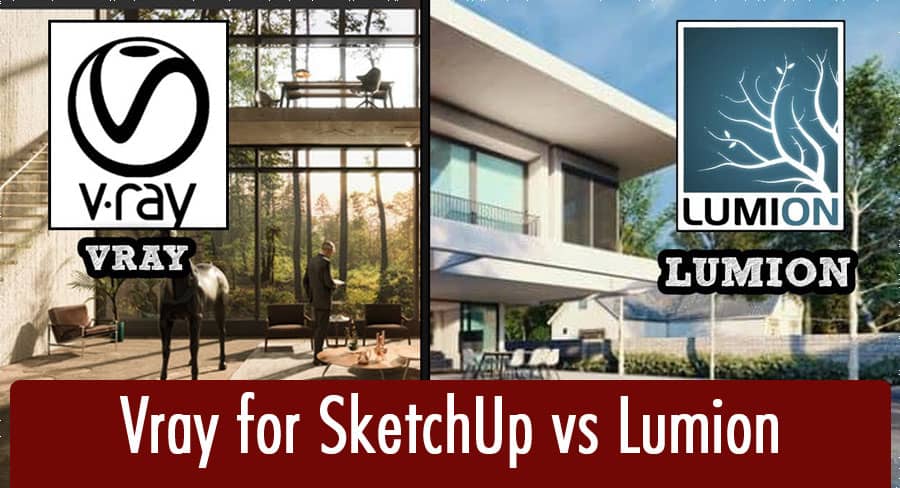Introduction
When it comes to architectural visualization, choosing the right rendering software can significantly impact the quality and efficiency of your workflow. In this article, we will compare V-Ray for SketchUp and Lumion, two popular rendering tools, to help you make an informed decision. Both V-Ray and Lumion offer unique features and capabilities, so let’s dive in and explore which one is right for you.
Understanding V-Ray for SketchUp
Before we delve into the comparison, let’s briefly understand V-Ray for SketchUp:
- What is V-Ray for SketchUp?: Discover the power and flexibility of V-Ray, a renowned rendering engine that seamlessly integrates with SketchUp, a popular 3D modeling software.
- Benefits of V-Ray for SketchUp: Explore the advantages of using V-Ray for architectural visualization, including its advanced lighting, material, and post-processing capabilities.
Exploring Lumion
Now, let’s familiarize ourselves with Lumion:
- What is Lumion?: Learn about Lumion, a real-time 3D visualization software that allows architects and designers to create immersive experiences of their projects.
- Key Features of Lumion: Explore the real-time rendering, vast material library, and intuitive interface that make Lumion a preferred choice for architectural visualization.
Key Differences
- Rendering Approach: Understand the fundamental differences in the rendering approaches of V-Ray and Lumion, including real-time rendering versus offline rendering.
- Workflow and Ease of Use: Compare the workflow and user experience of both software, including the learning curve, interface, and integration with 3D modeling tools.
Rendering Capabilities
- Quality and Realism: Evaluate the rendering quality and realism achievable with V-Ray and Lumion, considering factors such as lighting, materials, and overall visual fidelity.
- Speed and Interactivity: Assess the rendering speed and interactivity of both software, as well as their ability to handle complex scenes efficiently.
Workflow and Ease of Use
- Integration with SketchUp: Analyze the level of integration and compatibility between V-Ray and SketchUp, and how seamlessly they work together.
- Importing and Scene Setup: Compare the ease of importing 3D models and setting up scenes in V-Ray and Lumion.
- Material Creation and Editing: Evaluate the material creation and editing capabilities of both software, including texture mapping and material libraries.
Material and Lighting Options
- Material Libraries: Explore the pre-built material libraries provided by V-Ray and Lumion and assess their variety and quality.
- Lighting Tools: Compare the lighting tools available in both software, such as natural lighting simulations, artificial lighting setups, and light effects.
Post-processing and Effects
- Post-processing Capabilities: Evaluate the post-processing capabilities of V-Ray and Lumion, including options for adjusting exposure, color correction, and adding atmospheric effects.
- Special Effects: Assess the special effects and additional features offered by both software, such as foliage generation, particle effects, and object animations.
System Requirements
- Hardware Requirements: Understand the system requirements for V-Ray and Lumion, including considerations for CPU, GPU, RAM, and storage.
- Compatibility and Operating Systems: Check the compatibility of both software with different operating systems and versions.
Pricing and Licensing
- Pricing Models: Compare the pricing models and licensing options for V-Ray and Lumion, including perpetual licenses, subscription plans, and educational pricing.
Making the Right Choice
Considering the factors discussed, weigh the pros and cons of V-Ray and Lumion based on your specific requirements, workflow preferences, and budget.
Conclusion
In conclusion, both V-Ray for SketchUp and Lumion are powerful rendering tools, each with its strengths and target audience. V-Ray excels in providing advanced control, photorealism, and integration with SketchUp, making it a preferred choice for professionals seeking precise and realistic renderings. On the other hand, Lumion offers real-time rendering, an extensive material library, and an intuitive interface, making it ideal for quick visualizations and immersive experiences. Assess your needs, prioritize your requirements, and make an informed decision based on the comparison provided.
FAQs
Can I use V-Ray and Lumion together?
Yes, you can use V-Ray and Lumion together. You can create your base model and detailed renderings in SketchUp with V-Ray and then export the model to Lumion for real-time visualization and walkthroughs.
Which software is more beginner-friendly, V-Ray or Lumion?
Lumion is generally considered more beginner-friendly due to its intuitive interface and real-time rendering capabilities. However, V-Ray offers comprehensive documentation and extensive online resources to support beginners in mastering the software.
Are there any limitations on scene complexity in V-Ray and Lumion?
Both V-Ray and Lumion can handle complex scenes, but there may be performance considerations depending on the specifications of your hardware. It is recommended to optimize your scenes and adjust the rendering settings accordingly.
Can I try V-Ray and Lumion before purchasing?
Yes, both V-Ray and Lumion offer trial versions that allow you to explore the software and evaluate its features before making a purchase.
Where can I get access to V-Ray for SketchUp or Lumion?
For access to V-Ray for SketchUp or Lumion, visit their official websites and explore their pricing and licensing options.


